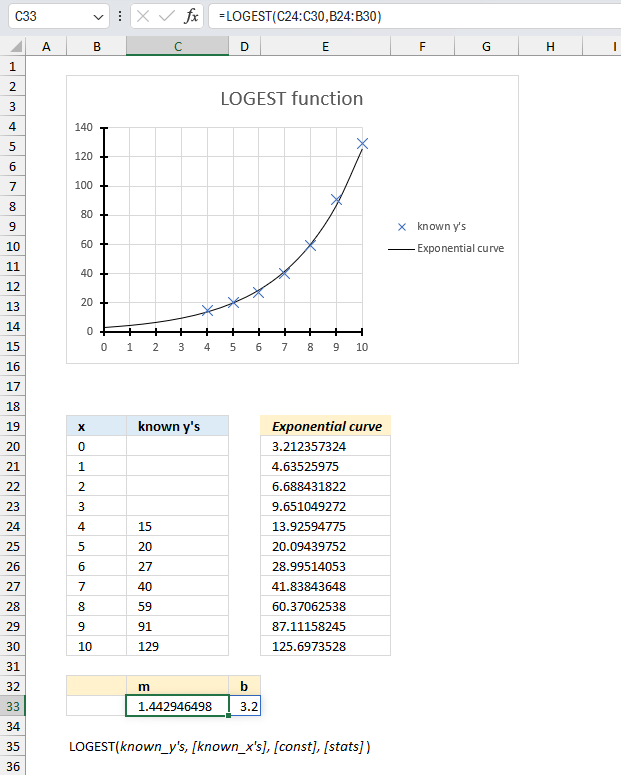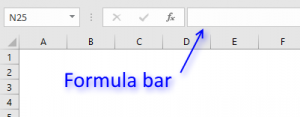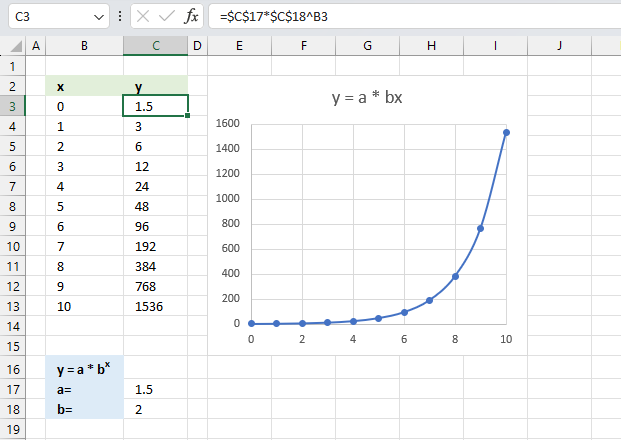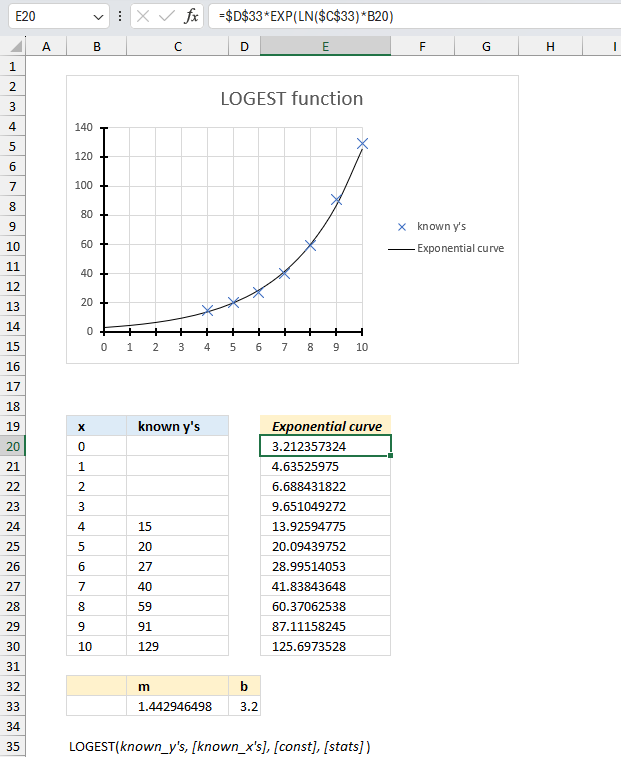How to use the LOGEST function

What is the LOGEST function?
The LOGEST function returns an array of values representing the parameters of an exponential curve that fits your data, based on the "least squares" method. This function must be entered as an array formula.
Table of Contents
1. Introduction
What is an array formula?
An array formula is a formula that returns multiple values. In versions earlier than Excel 365 you have to follow these steps:
- Select the cell range that fits the output.
- Type or copy/paste the array formula in the formula bar.

- Press and hold CTRL and SHIFT keys simultaneously.
- Press Enter once.
- Release all keys.
The array formula in the formula bar changes so it also shows beginning and ending curly brackets like this: {=array_formula}
The curly brackets tell you that you successfully enter a formula as an array formula. The downside is that array formulas are easily broken when you edit the formula, you need to remember to repeat the steps above if you change the formula.
The good news is that Excel 365 simplified things a lot, you now enter regular and array formulas the same way simply by pressing the Enter key. Array formulas are now called dynamic array formulas meaning they automatically spill values to cells below and to the right as far as needed.
What is an exponential curve?

An exponential curve is a curve described by an exponential function of the form:
y = a * bx
a is the initial value when x = 0
b is the base (constant)
x is the independent variable
y is the dependent variable
How to fit data to an exponential curve using the "least squares" method?
The least squares method is a standard approach to fitting regression lines and curves to data by minimizing the sum of the squares of the residuals. It finds the "best" curve according to this squared error criterion.
What is the difference between the LOGEST and the LINEST function?
LINEST fits a straight line to your data whereas the LOGEST function fits an exponential curve.
2. LOGEST function Syntax
LOGEST(known_y's, [known_x's], [const], [stats])
3. LOGEST function Arguments
The equation for the curve is y = b*m^x or y = (b*(m1^x1)*(m2^x2)* ...) if multiple x-values are used. y, x and m can be vectors and LOGEST returns the following array: {mn, mn-1, ..., m1, b}. The m-values correspond to the x-values.
| known_y's | Required. Single column - Each row is a separate variable. Single row - Each column is a separate variable. |
| [known_x's] | Optional. Known x points, default values are 1, 2, 3, ... |
| [const] | Optional. A boolean value determining if constant b is equal to 0 (zero). TRUE - constant b is calculated. Default. FALSE - constant b is 0 (zero). |
| [stats] | Optional. A boolean value determining whether to calculate additional regression statistics. TRUE - Returns additional regression statistics. {mn, mn-1, ..., m1, b;sen, sen-1, ..., se1, seb;r2, sey;F, df;ssreg, ssresid} FALSE - returns only m and b. |
The following table shows what the LOGEST function returns if [stats] argument is TRUE.
| Statistic | Description |
| se1, se2, ..., sen | The standard error values. |
| seb | The standard error value for the constant b. seb returns #N/A when const argument is FALSE. |
| r2 | The coefficient of determination. A perfect correlation is 1 and 0 (zero) means no correlation based on comparing the actual and the LOGEST functions estimated y-values. |
| sey | The standard error for the estimated y-values. |
| F | The F statistic, or the F-observed value. Determines if the observed relationship between the dependent and independent variables occurs by chance. |
| df | The degrees of freedom assists you in finding F-critical values, then compare the values to the F statistic to get the confidence level for the model. |
| ssreg | The regression sum of squares. |
| ssresid | The residual sum of squares. |
What are standard error values?
Measure of accuracy of coefficient estimates. Lower standard error = more precise estimate.
What is coefficient of determination?
Proportion of response variation explained by model. Ranges 0 to 1. Higher is better fit.
What is F statistic or the F-observed value?
Ratio of model mean square to residual mean square. Tests overall fit. Higher F indicates more significance.
What are degrees of freedom?
Numbers of independent observations minus number of fitted coefficients. Used in F test.
What is the confidence level for the model?
Probability that coefficient confidence interval contains true value. 95% is commonly used. Based on standard error.
What is regression sum of squares?
Variation explained by the model. Should be large relative to residual sum of squares.
What is the residual sum of squares?
Variation NOT explained by the model. Should be small relative to regression SS.
4. LOGEST Function Example

A lab has recorded the number of bacteria in a culture every hour from the 4th hour to the 10th hour. How can the LOGEST function help determine the best fitted exponential curve? Here is the data:
| 0 | |
| 1 | |
| 2 | |
| 3 | |
| 4 | 15 |
| 5 | 20 |
| 6 | 27 |
| 7 | 40 |
| 8 | 59 |
| 9 | 91 |
| 10 | 129 |
The image above shows the data in cell range B19:C30. The array formula calculates the m and b coefficients for an exponential curve that best fits the given data points.
Array formula in cell range C16:D16:
The LOGEST function returns an m value of approx. 1.44 and a b value of 3.2. The chart above shows these data points as blue markers. The black line represents an exponential curve using the "least squares" method. Section 4.2 below demonstrates how this curve is calculated.
4.1 How to enter an array formula
Excel 365 subscribers can skip the following instructions.
To enter an array formula, type the formula in a cell then press and hold CTRL + SHIFT simultaneously, now press Enter once. Release all keys.
The formula bar now shows the formula with a beginning and ending curly bracket telling you that you entered the formula successfully. Don't enter the curly brackets yourself.
4.2 How to calculate exponential curve based on m and b coefficients

Use the following formula to calculate y coordinates based on m and b coefficients calculated in cells C16:D16
Formula in cell E20:
The calculated data points in cells E20:E30 are the plotted exponential curve together with the "source data" shown as x markers on the chart.
Use the GROWTH function to predict future values.
5. Function not working

The LOGEST function returns
- #VALUE! error if you use a non-numeric input value.
- #NAME? error if you misspell the function name.
- propagates errors, meaning that if the input contains an error (e.g., #VALUE!, #REF!), the function will return the same error
5.1 Troubleshooting the error value

When you encounter an error value in a cell a warning symbol appears, displayed in the image above. Press with mouse on it to see a pop-up menu that lets you get more information about the error.
- The first line describes the error if you press with left mouse button on it.
- The second line opens a pane that explains the error in greater detail.
- The third line takes you to the "Evaluate Formula" tool, a dialog box appears allowing you to examine the formula in greater detail.
- This line lets you ignore the error value meaning the warning icon disappears, however, the error is still in the cell.
- The fifth line lets you edit the formula in the Formula bar.
- The sixth line opens the Excel settings so you can adjust the Error Checking Options.
Here are a few of the most common Excel errors you may encounter.
#NULL error - This error occurs most often if you by mistake use a space character in a formula where it shouldn't be. Excel interprets a space character as an intersection operator. If the ranges don't intersect an #NULL error is returned. The #NULL! error occurs when a formula attempts to calculate the intersection of two ranges that do not actually intersect. This can happen when the wrong range operator is used in the formula, or when the intersection operator (represented by a space character) is used between two ranges that do not overlap. To fix this error double check that the ranges referenced in the formula that use the intersection operator actually have cells in common.
#SPILL error - The #SPILL! error occurs only in version Excel 365 and is caused by a dynamic array being to large, meaning there are cells below and/or to the right that are not empty. This prevents the dynamic array formula expanding into new empty cells.
#DIV/0 error - This error happens if you try to divide a number by 0 (zero) or a value that equates to zero which is not possible mathematically.
#VALUE error - The #VALUE error occurs when a formula has a value that is of the wrong data type. Such as text where a number is expected or when dates are evaluated as text.
#REF error - The #REF error happens when a cell reference is invalid. This can happen if a cell is deleted that is referenced by a formula.
#NAME error - The #NAME error happens if you misspelled a function or a named range.
#NUM error - The #NUM error shows up when you try to use invalid numeric values in formulas, like square root of a negative number.
#N/A error - The #N/A error happens when a value is not available for a formula or found in a given cell range, for example in the VLOOKUP or MATCH functions.
#GETTING_DATA error - The #GETTING_DATA error shows while external sources are loading, this can indicate a delay in fetching the data or that the external source is unavailable right now.
5.2 The formula returns an unexpected value

To understand why a formula returns an unexpected value we need to examine the calculations steps in detail. Luckily, Excel has a tool that is really handy in these situations. Here is how to troubleshoot a formula:
- Select the cell containing the formula you want to examine in detail.
- Go to tab “Formulas” on the ribbon.
- Press with left mouse button on "Evaluate Formula" button. A dialog box appears.
The formula appears in a white field inside the dialog box. Underlined expressions are calculations being processed in the next step. The italicized expression is the most recent result. The buttons at the bottom of the dialog box allows you to evaluate the formula in smaller calculations which you control. - Press with left mouse button on the "Evaluate" button located at the bottom of the dialog box to process the underlined expression.
- Repeat pressing the "Evaluate" button until you have seen all calculations step by step. This allows you to examine the formula in greater detail and hopefully find the culprit.
- Press "Close" button to dismiss the dialog box.

There is also another way to debug formulas using the function key F9. F9 is especially useful if you have a feeling that a specific part of the formula is the issue, this makes it faster than the "Evaluate Formula" tool since you don't need to go through all calculations to find the issue..
- Enter Edit mode: Double-press with left mouse button on the cell or press F2 to enter Edit mode for the formula.
- Select part of the formula: Highlight the specific part of the formula you want to evaluate. You can select and evaluate any part of the formula that could work as a standalone formula.
- Press F9: This will calculate and display the result of just that selected portion.
- Evaluate step-by-step: You can select and evaluate different parts of the formula to see intermediate results.
- Check for errors: This allows you to pinpoint which part of a complex formula may be causing an error.
The image above shows cell reference B24:B30 converted to hard-coded value using the F9 key. The LOGEST function requires numerical values which is not the case in this example. We have found what is wrong with the formula.
Tips!
- View actual values: Selecting a cell reference and pressing F9 will show the actual values in those cells.
- Exit safely: Press Esc to exit Edit mode without changing the formula. Don't press Enter, as that would replace the formula part with the calculated value.
- Full recalculation: Pressing F9 outside of Edit mode will recalculate all formulas in the workbook.
Remember to be careful not to accidentally overwrite parts of your formula when using F9. Always exit with Esc rather than Enter to preserve the original formula. However, if you make a mistake overwriting the formula it is not the end of the world. You can “undo” the action by pressing keyboard shortcut keys CTRL + z or pressing the “Undo” button
5.3 Other errors
Floating-point arithmetic may give inaccurate results in Excel - Article
Floating-point errors are usually very small, often beyond the 15th decimal place, and in most cases don't affect calculations significantly.
Functions in 'Statistical' category
The LOGEST function function is one of 73 functions in the 'Statistical' category.
How to comment
How to add a formula to your comment
<code>Insert your formula here.</code>
Convert less than and larger than signs
Use html character entities instead of less than and larger than signs.
< becomes < and > becomes >
How to add VBA code to your comment
[vb 1="vbnet" language=","]
Put your VBA code here.
[/vb]
How to add a picture to your comment:
Upload picture to postimage.org or imgur
Paste image link to your comment.
Contact Oscar
You can contact me through this contact form